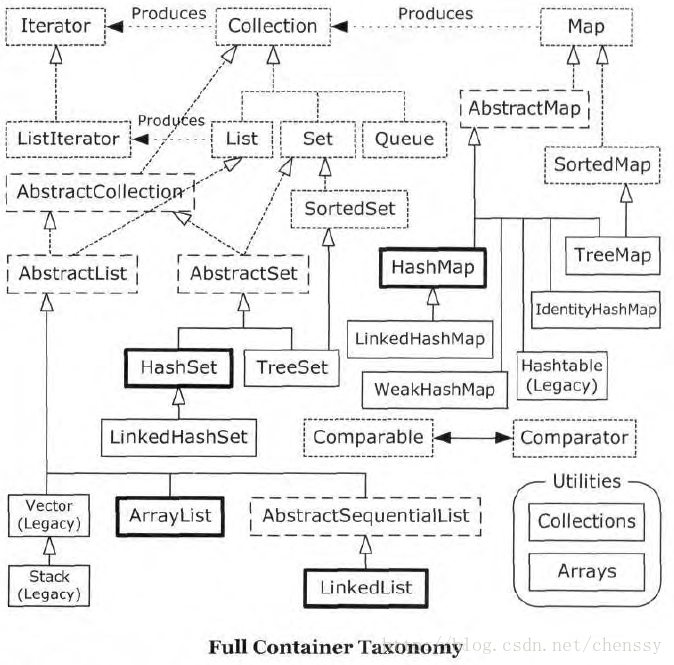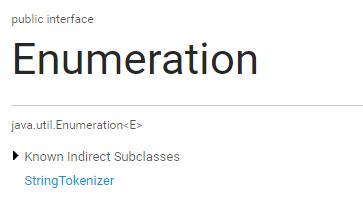Java 集合原始碼解析(1):Iterator
Java 提供的 集合類都在 Java.utils 包下,其中包含了很多 List, Set, Map, Queue… 它們的關係如下面這張類圖所示:
可以看到,Java 集合主要分為兩類:Collection 和 Map. 而 Collection 又繼承了 Iterable< E > 介面,Iterable 介面內只有一個 iterator 方法,返回一個 Iterator 迭代器:
public interface Iterable<T> { /** * Returns an {@link Iterator} for the elements in this object. * * @return An {@code Iterator} instance. */ Iterator<T> iterator(); }
本篇文章將介紹 Iterator 迭代器。 在介紹 Iterator 之前不得不提一下被它替代的 Enumeration< E >:
Enumeration< E >
public interface Enumeration<E> { /** * Returns whether this {@code Enumeration} has more elements. * * @return {@code true} if there are more elements, {@code false} otherwise. * @see #nextElement */ public boolean hasMoreElements(); /** * Returns the next element in this {@code Enumeration}. * * @return the next element.. * @throws NoSuchElementException * if there are no more elements. * @see #hasMoreElements */ public E nextElement(); }
Enumeration 是一個很古老的迭代器,有兩個方法:
- hasMoreElements() //是否還有元素
- nextElement() //返回下一個元素
Enumeration 的實現類會生成一系列子元素,比如 StringTokenizer;通過 Enumeration 的上述兩個方法可以用來遍歷它實現類的元素,比如這樣:
//StringTokenizer : 切割, Breaks a string into tokens; new code should probably use {@link String#split}. Enumeration enumeration = new StringTokenizer("A-B-C", "-"); while (enumeration.hasMoreElements()){ System.out.println(enumeration.nextElement()); }
執行結果:
Enumeration 介面早在 JDK 1.0 時就推出了,當時比較早的容器比如 Hashtable, Vector 都使用它作為遍歷工具。
那 Enumeration 為什麼會被廢棄呢?
根據官方文件:
NOTE: The functionality of this interface is duplicated by the Iterator interface. In addition, Iterator adds an optional remove operation, and has shorter method names. New implementations should consider using Iterator in preference to Enumeration.
可以大膽猜一下,應該是當初設計沒有考慮全,只有兩個方法,而且名字還太長了 - -。 後來在 JDK 1.2 推出了 Iterator 替代它的功能。雖然 Enumeration 在 JDK 1.5 後增加了泛型的應用,依舊大勢已去。
Iterator
Iterator 是一個集合上的迭代器,用來替代 Enumeration 進行遍歷、迭代。
它 和 Enumeration 有什麼不同呢?
根據官方文件:
Iterators differ from enumerations in two ways:
- Iterators allow the caller to remove elements from the underlying collection during the iteration with well-defined semantics.
- Method names have been improved.
哈哈首先是名字縮短了,看來大家都懶得輸入那麼長的方法名。 其次是 允許呼叫者在遍歷過程中語法正確地刪除元素。
注意這個 [語法正確],事實上我們在使用 Iterator 對容器進行迭代時如果修改容器 可能會報 ConcurrentModificationException 的錯。官方稱這種情況下的迭代器是 fail-fast 迭代器。
fail-fast 與 ConcurrentModificationException
以 ArrayList 為例,在呼叫迭代器的 next,remove 方法時:
public E next() {
if (expectedModCount == modCount) {
try {
E result = get(pos + 1);
lastPosition = ++pos;
return result;
} catch (IndexOutOfBoundsException e) {
throw new NoSuchElementException();
}
}
throw new ConcurrentModificationException();
}
public void remove() {
if (this.lastPosition == -1) {
throw new IllegalStateException();
}
if (expectedModCount != modCount) {
throw new ConcurrentModificationException();
}
try {
AbstractList.this.remove(lastPosition);
} catch (IndexOutOfBoundsException e) {
throw new ConcurrentModificationException();
}
expectedModCount = modCount;
if (pos == lastPosition) {
pos--;
}
lastPosition = -1;
}
可以看到在呼叫迭代器的 next,remove 方法時都會比較 expectedModCount 和 modCount 是否相等,如果不相等就會丟擲 ConcurrentModificationException ,也就是成為了 fail-fast。
而 modCount 在 add, clear, remove 時都會被修改:
public boolean add(E object) {
//...
modCount++;
return true;
}
public void clear() {
if (size != 0) {
//...
modCount++;
}
}
public boolean remove(Object object) {
Object[] a = array;
int s = size;
if (object != null) {
for (int i = 0; i < s; i++) {
if (object.equals(a[i])) {
//...
modCount++;
return true;
}
}
} else {
for (int i = 0; i < s; i++) {
if (a[i] == null) {
//...
modCount++;
return true;
}
}
}
return false;
}
因此我們知道了 fail-fast 即 ConcurrentModificationException 出現的原因,怎麼解決呢?
方法一:
用 CopyOnWriteArrayList,ConcurrentHashMap 替換 ArrayList, HashMap,它們的功能和名字一樣,在寫入時會建立一個 copy,然後在這個 copy 版本上進行修改操作,這樣就不會影響原來的迭代。不過壞處就是浪費記憶體。
方法二:
使用 Collections.synchronizedList 加 同步鎖,不過這樣有點粗暴。
可能得方法三(待考究,目前我還沒搞清楚):
在學習 ListView 中的觀察者模式 時,我注意到 DataSetObservable 的 notifyChanged 方法中有如下注釋:
public void notifyChanged() {
synchronized(mObservers) {
// since onChanged() is implemented by the app, it could do anything, including
// removing itself from {@link mObservers} - and that could cause problems if
// an iterator is used on the ArrayList {@link mObservers}.
// to avoid such problems, just march thru the list in the reverse order.
for (int i = mObservers.size() - 1; i >= 0; i--) {
mObservers.get(i).onChanged();
}
}
}
to avoid such problems, just march thru the list in the reverse order
為了避免影響 ArrayList 迭代,倒序處理。 待考究,目前我還沒搞清楚。
不過意外的發現了,原來 for-each 的迴圈內部也是使用了 Iterator 來遍歷Collection,它也呼叫了 Iterator.next(),所以在修改元素時會檢查(元素的)變化並丟擲 ConcurrentModificationException。
在從任何 Collection中刪除物件時總要使用 Iterator 的remove 方法, for-each 迴圈只是標準 Iterator 程式碼標準用法之上的一種語法糖(syntactic sugar)而已。
差點忘了 Iterator 的使用
所有 Collection 的子類都有 iterator() 方法來獲得 Iterator,通過 Iterator 的標準操作方法,可以讓我們不必關心具體集合的型別,從而避免向客戶端暴露出集合的內部結構。
不使用 Iterator 遍歷集合是這樣的:
for(int i=0; i<集合的大小;i++){
// ...
}
使用 Iterator 遍歷集合是這樣的:
Iterator iterator = list.iterator();
while (iterator.hasNext()){
System.out.println(iterator.next());
}
對比而言,後者客戶端程式碼與具體集合型別耦合性弱,複用性更強。缺點就是無法獲取指定的元素,只能挨個遍歷。




